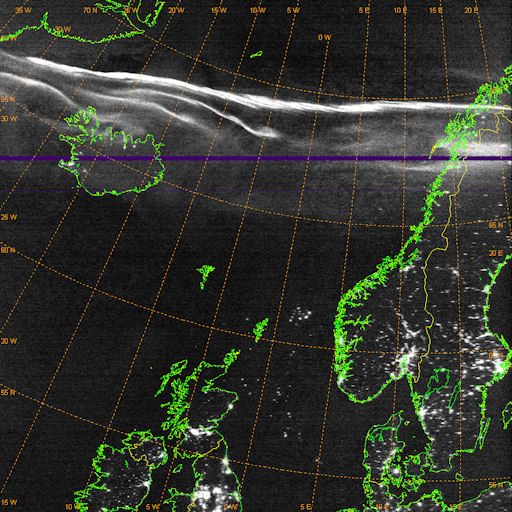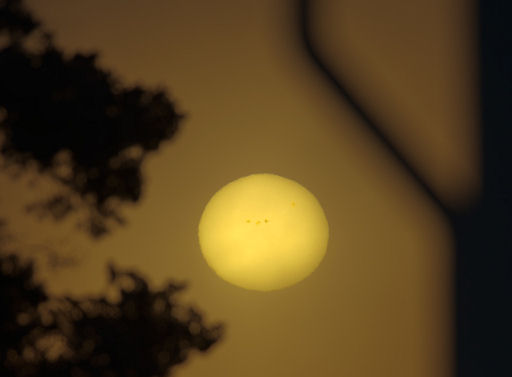CHANCE OF FLARES: NOAA forecasters estimate a 60% chance of M-class solar flares, and a 5% chance of X-flares today. The probable source would be big sunspot AR1654, which is squarely facing Earth. Solar flare alerts: text, voice.
AURORAS BY SATELLITE: A solar wind stream hit Earth's magnetic field on Jan. 13th, igniting bright auroras around the Arctic Circle. A US Department of Defense meteorological satellite photographed the luminous tendrils winding past Iceland:
Mark Conner of the Air Force Weather Agency prepared the image using data from a low-light camera onboard the DMSP-18 satellite. It shows not only the auroras, but also the city lights of northern Europe and the glow of gas flares from oil rigs in the North Sea. The auroras were every bit as bright as the manmade lights below. The view from the ground proves the comparison.
More auroras are in the offing. NOAA forecasters estimate a 15% chance of polar geomagnetic activity as the solar wind continues to blow. Aurora alerts: text, voice.
BIG SUNSPOTS IN THE MORNING: Sunspot AR1654 is so large, people are starting to notice it with their naked eyes when the sun is dimmed by clouds or mist. This morning, Jan. 14th, Göran Strand photographed the behemoth at sunrise over Frösön, Sweden:
"The weather was very cold, -20 degrees Celsius and there was a light mist that made it possible to shoot right at the Sun without any filters," says Strand. "In the foreground you can see the downpipes on my neighbor's house."
To take the picture, Strand set his Nikon D800E digital camera as follows: 510mm/f4.8, ISO 400, 1/6000 sec. Sky watchers who wish to photograph the spot should take note of those settings, but be careful. Even when the sun is dimmed, viewing it through unfiltered optics is every dangerous. One stray beam of magnified sunlight can blind you. Use the digital viewfinder to safely align the camera.

![]()
Solar wind
speed: 432.8 km/sec
density: 2.3 protons/cm3
explanation | more data
Updated: Today at 1717 UT
![]()
X-ray Solar Flares
6-hr max: C1 1210 UT Jan15
24-hr: C2 0556 UT Jan15
explanation | more data
Updated: Today at: 1700 UT
![]()
![]()
![]()
Daily Sun: 15 Jan 13
![]()
![]()
Sunspot AR1654 has a beta-gamma magnetic field that harbors energy for M-class solar flares. Credit: SDO/HMI
![]()
![]()
![]()
Sunspot number: 128
What is the sunspot number?
Updated 15 Jan 2013
Spotless Days
Current Stretch: 0 days
2012 total: 0 days (0%)
2011 total: 2 days (<1%)
2010 total: 51 days (14%)
2009 total: 260 days (71%)
Since 2004: 821 days
Typical Solar Min: 486 days
Update 15 Jan 2013
The Radio Sun
10.7 cm flux: 154 sfu
explanation | more data
Updated 15 Jan 2013
![]()
![]()
![]()
Current Auroral Oval:
![]()
Switch to: Europe, USA, New Zealand, Antarctica
Credit: NOAA/POES
![]()
![]()
![]()
Planetary K-index
Now: Kp= 1 quiet
24-hr max: Kp= 2 quiet
explanation | more data
![]()
Interplanetary Mag. Field
Btotal: 4.2 nT
Bz: 0.3 nT south
explanation | more data
Updated: Today at 1557 UT
![]()
![]()
![]()
Coronal Holes: 15 Jan 13
![]()
![]()
There are no large coronal holes on the Earthside of the sun. Credit: SDO/AIA






